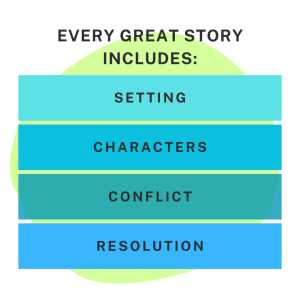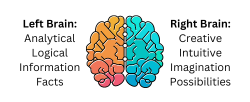13 Storytelling in Teams
jknevitt
Business Storytelling for Teams
Storytelling is a uniquely human activity. Our brains are wired to retain information told in the format of a story. In business presentations, a good story or anecdote gets the audience’s attention and makes the information more memorable. However, not just any story will do. A team needs to analyze the intended audience, do research on the topic, and settle on a framework for the presentation before deciding which story or stories to tell.
The following TED Talk by Kelly Parker makes the case for business storytelling, and why it is worth considering for team presentations:
Although research supports the use of storytelling, many speakers are reluctant to include stories in business presentations. What is storytelling in business, and how can a team be effective in building and telling a story?
In this chapter, you will learn:
- What is storytelling?
- Elements of storytelling
- Effective storytelling practices
What is storytelling?
Simply put, a story is an account of incidents or events, or a statement about the facts or circumstances pertinent to an event. Sounds boring, doesn’t it? However, a story is anything but boring to the human mind. In daily life, we are surrounded by stories. Think of the last conversation you had. Chances are, you told or heard a story or two. Think of the last movie you watched, the last book you read, the last ad you saw for a product. Stories made that movie, that book, and that ad memorable. Stories have the power to make a business presentation memorable, move the audience to action, and influence others to make certain decisions.
Every story has four basic elements. Those elements are: Setting, characters, conflict, and resolution.

All four elements must be present for the story to make sense and have impact. What do each of the elements bring to the storytelling process?
Setting: The setting provides the focus of the story, the environment that the story takes place in, and the knowledge that the audience needs to have to understand the other elements of the story.
Characters: In business presentations, the characters are generally portrayed as customers, suppliers, partners, employees, or key stakeholders. The characters in a business story should help your audience relate to the situation or problem you are addressing because they see themselves through these characters.
Conflict: The audience needs a reason to listen, and conflict, or tension, supplies this need. No great story is worth listening to unless there is an element of conflict. The conflict will lead to understanding in the minds of the audience, and that understanding will lead the audience to the actions that the speakers would like to influence.
Resolution: This is the purpose of telling a story in the first place. In the resolution, the speaker solves the conflict that has built throughout the story, moving the audience to action.
Effective storytelling practices
How should a team infuse storytelling into a business presentation? There are several ways to tell stories in business. Two of the most common techniques are: Include an overarching storyline that encompasses the entire presentation or use one or more anecdotes to make certain points stand out or move the audience to a course of action.
There are five key aspects to storytelling success in business presentations: Simplicity, authenticity, imagery, relatability, and emotion.
Simplicity: Stories and anecdotes used in business presentations need to be focused on the goals and theme of the presentation and should not be too complex for the speaker to relate or for the audience to understand.
Authenticity: This is an element of public speaking that builds credibility and trust with an audience. People are drawn to true stories that reflect real-life experiences.
Imagery: All great stories contain rich detail and allow the audience to identify with the emotions and actions taking place.
Relatability: Every public speaker needs to ask themselves if the stories and experiences they choose relate to the goals and theme of the presentation. If not, leave it out.
Emotion: One of the most powerful elements of storytelling is the use of emotion. Emotion spurs action in the audience and is an important element of persuasion.
Every effective presentation starts with an analysis of the audience. What is the makeup of the audience and what do they care about? All stories should be focused not only on the theme of the presentation, but also on the makeup of the audience.
There’s a reason that successful storytelling gets the attention of a business audience and motivates them to make certain choices. A story activates the two hemispheres of the brain. The left side of the brain is logical and analytical, while the right side of the brain is creative and visual. Humans use both hemispheres to make decisions.

To influence others in a business presentation, it is critical to activate both hemispheres of the brain. If a presentation appeals only to the left side of the brain with facts and data, the audience cannot process many facts all at once. To make the facts and data stick in the minds of the audience, the right hemisphere of their brains needs context. That context is best presented in the form of stories.
Avoid the data dump
A story or series of stories adds context and color to the logical and factual data that comprise most business presentations. Many presentations, however, can best be described as a “data dump”, where facts and information is presented to the audience without the benefit of creative language, imagination, and possibilities in the form of storytelling. To motivate the audience to act, they need to see more than just the relevant data. The audience needs to understand the “why” or “how” and storytelling has the benefit of putting all the relevant data into context with insights. Insights have the power to change how the audience understands an issue or topic and transforms their thinking. The best way to present insights is by using stories that contextualize the data. Carefully select data to build a narrative journey that will work through a handful of data insights.
Let’s put storytelling to the test. In the following two examples, you’ll see how storytelling adds context, insights, and motivates the audience more than just data alone.
Business Case for DEI (Data Only Approach)
Companies with greater gender diversity are 25% more likely to experience above average profitability. Companies with greater ethnic and cultural diversity are 36% more likely to experience above average profitability. However, diversity itself does not guarantee inclusion. Even though representation is critical, it alone cannot guarantee that people will be treated with equity and inclusion in actual practice. Organizations that struggle to comprehend why they are unable to retain diverse talent should assess practices, policies, and procedures carefully.
Business Case for DEI (Story-based Approach)
As a college senior and “dreamer,” Natasha had been recruited to work with XYZ Corporation and thought it would be a great place to start a career. “The opportunities for skill development were incredible, and I chose XYZ thanks to its strong commitment to diversity,” states Natasha. It didn’t take long, however, for Natasha to realize that the company’s commitment to diversity was only on the surface. “It slowly became clear that although the company had mindfully hired a diverse group of people, they had no idea how to make everyone feel welcome and included,” she laments. Women and minority workers were routinely overlooked for promotion and felt left out of the culture. After a year, Natasha reluctantly concluded that she would not be able to make an impact at XYZ Corporation, and followed many women and minority workers out the door to companies who valued their contributions. “I ended up quitting, and going to a company that made me feel more at home and included in the culture, somewhere that I could exert greater impact,” Natasha said. By failing to consider inclusion and equity along with diversity, XYZ missed an opportunity. Companies with greater gender diversity are 25% more likely to experience above average profitability, and companies with greater ethnic and cultural diversity are 36% more likely to experience above average profitability. In order to tap into that higher level profitability, companies must invest in inclusive and equitable practices that make workers like Natasha want to stick around.
The same basic information was presented in both examples. However, the example that included a story provided context in a memorable framework. To make data stick, a speaker needs to awaken both the left and right brains of their audience by combining facts and data with a compelling story.
Conclusion
Storytelling is an effective method to get the attention of an audience, build rapport, and engage with business topics. People love stories, and business audiences are no different. The four most important elements of a story in a business presentation are: Setting, characters, context, and resolution. When both hemispheres of the brain are engaged with data, facts, emotions, and creativity, and audience is more likely to retain the information in the presentation and be motivated to act.

